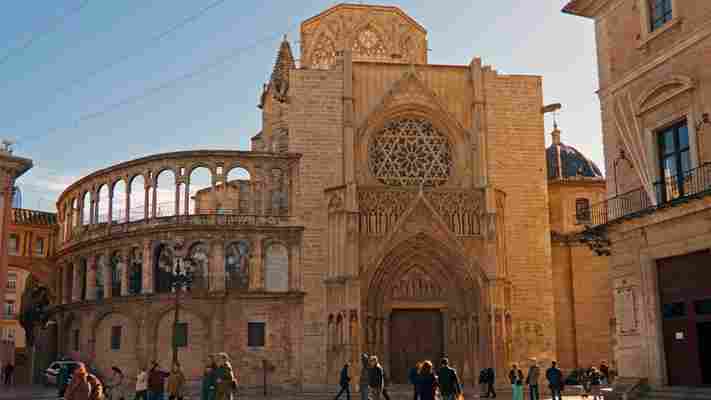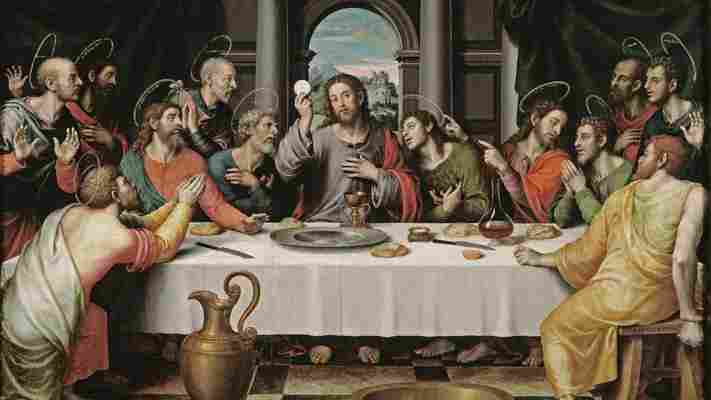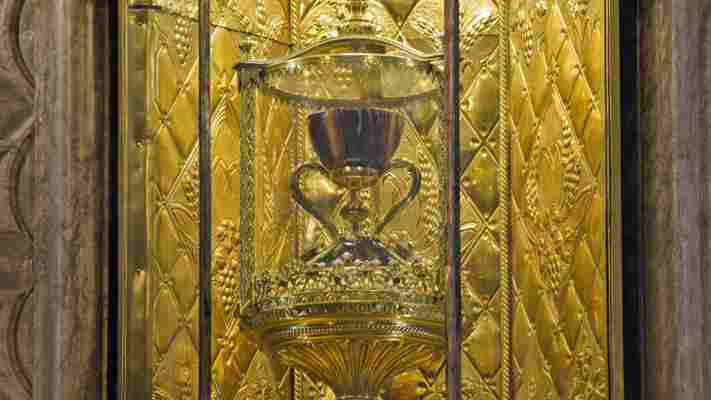Article continues below
It is difficult to enter the Valencia Cathedral without feeling a sense of awe. Upon crossing the threshold, I was greeted with the echoes of a Gregorian chant that reverberated across the vaulted ceiling. Stretched before me was a long procession of archways leading to a single dais on the far side of the cathedral. A small set of steps climbed up to the altar, which was encased by a half dome immaculately adorned with sculptures and paintings depicting scenes of angels and the apostles.
But I hadn’t come to Spain’s third-largest city for the views of its cathedral. Instead, I made my way to a small room just off to the side, one so nondescript that I’d nearly missed it on first glance. Within this humble chapel, encased in glass just beyond the altar, was the object I was searching for: a single cup, resting upon an illuminated golden pedestal. As legend has it, this is the very cup used by Jesus Christ during the Last Supper – or, as the cup is more commonly known, the Holy Grail.

The Valencia Cathedral houses what is said to be the Holy Grail (Credit: Angel Villalba/Getty Images)
You may also be interested in: • Was this the first Dead Sea Scroll? • A rare glimpse at Jesus’ burial chamber • The world’s first Christian country?
Appearing in stories from the medieval epics of King Arthur and his knights to the silver-screen exploits of Indiana Jones, the Holy Grail has remained one of humanity’s most sought-after treasures, a mysterious relic that straddles the line between fantasy and reality. Though the idea that a chalice used by Christ would be revered and therefore preserved by early worshippers is a plausible one, a magical vessel capable of granting eternal life is never mentioned in the Bible; it’s convention of Arthurian legend, penned by the likes of Chrétien de Troyes and Robert de Boron, two French poets who heavily shaped the development of Arthurian lore in the 12th and 13th Centuries. The first written mention of the grail as we’ve come to know it is in de Troyes’ Perceval, in which it is described not as a chalice but as a serving dish, likely harkening to the magical cauldrons of Celtic myth.
Growing up on the mythical tales of King Arthur, I’ve always been a sceptic; for me, the grail is a literary treasure. Even so, I couldn’t help but feel intrigued by Valencia’s Santo Cáliz (Holy Chalice). There are currently more than 200 claimants in Europe alone, all vying for the illustrious title of Holy Grail, with theories of the relic’s final resting place found everywhere from Scotland to Accokeek, Maryland . Yet out of all the lists of claimants I researched, Valencia’s chalice almost invariably held the top spot. It still manages to attract pilgrims from all over the world, and has even been used ceremonially by both Pope John Paul II and Pope Benedict XVI. Eager for the opportunity to follow in the footsteps of Sir Galahad on my own quest for the grail, I’d come here to discover what makes this cup so special among so many others.

The Holy Grail was the cup used by Jesus Christ during the Last Supper (Credit: Heritage Images/Getty Images)
I walked into La Capilla del Santo Cáliz (Chapel of the Chalice) to find it empty. Although my timing was unintentional, I’d arrived at the cathedral in the middle of a mass for Holy Saturday, the day before Easter Sunday, which meant that all the visitors were preoccupied with the ceremony in the adjacent room. A single beam of light streamed down from a stained-glass window far above the altar; the gentle hum of the distant choir was the only sound within the chapel. Though I had come to the place more as a researcher than a pilgrim, it was hard not to be taken by the quiet solemnity of the moment.
As I approached the altar to inspect the chalice more closely, I found it far more elaborate than I’d anticipated. With two massive gold handles and a base inlaid with pearls, emeralds and rubies, the chalice immediately filled me with a sense of incredulity. Indeed, as anyone who has seen Indiana Jones and the Last Crusade is aware, the Holy Grail should be a simple thing – the cup of a carpenter.
I was later informed by one of the attendants just outside the room that the actual relic is merely the piece at the top, a cup hewn from agate and polished with myrrh. The handles and base, which bear the hallmarks of medieval craftsmanship, weren’t added until much later. My scepticism temporarily assuaged, I turned to the task of discovering how this cup supposedly made the journey from Jerusalem, where the Last Supper is believed to have taken place, to the east coast of Spain.

The chalice is carved from agate and features large gold handles and a base inlaid with precious gems (Credit: Quinn Hargitai)
As with all stories of grail claimants, the tale is convoluted. An attendant of the cathedral was able to provide a basic explanation of how the chalice first made its way out of Jerusalem, some 2,000 years ago.
“St Peter, the first pope, took the cup to Rome,” she explained. “The popes were the only people who could give mass, so St Peter and the rest of popes used the grail for the Eucharist, considering it the one Christ used. Then, when the Emperor Valerian began to persecute the Christians [from 257 AD], it was sent to Huesca, Spain, because it was no longer safe in Rome.”
It is a mysterious relic that straddles the line between fantasy and reality
She went on to explain that the chalice supposedly rested in Huesca for a few hundred years, before being moved again during the Umayyad conquests of the 8th Century, nestled in the cliff-side monastery of San Juan de la Peña in northern Spain for fear of plundering.
Granted, accounts of these first thousand years of the grail’s journeys are beyond anyone’s ability to verify. The more reliable records of this chalice appear in 1399, when it became part King Martin of Aragon’s royal reliquary. According to the cathedral’s records, after Alfonso the Magnanimous took the throne in 1416, the reliquary was moved to Valencia and later given to the cathedral as a payment for a debt. Though the chalice was spirited away a few more times on the occasion of war, it inevitably returned to the Valencia Cathedral in 1939 – this time for good.
According to legend, the cup was brought to Spain from Rome during Emperor Valerian’s persecution of Christians in the 3rd Century AD (Credit: Quinn Hargitai)
Though an elaborate account, the story alone was not enough to make me believe this was the one true grail. After all, nearly all the grail claimants boast complex tales of how the relic was carried across seas and over mountains. Since none of the accounts can be verified, what has made so many believe that this is the one?
The main detail that sets the Valencia chalice apart is the style and craft of the agate cup, which Spanish archaeologist Antonio Beltrán, who studied the chalice in 1960, claims indicates an origin somewhere between the 2nd Century BC to the 1st Century AD, likely from a workshop in the Middle East. The archaeological assessment suggests that this cup fits the bill, at least geographically and chronologically. Though far from definitive proof, the findings certainly bolster the chalice’s claim.
The true wonder of the Holy Grail was never in the finding, but in the searching
As I stared at the agate cup resting in its glass case, there was one thought that continued to occupy my mind. If this was in fact the Holy Grail, one of the most legendary artefacts of all time, could it really be this easy? This was supposed to be the cup sought after time and time again by the heroes of old, only ever attained by those of purest heart – and yet here it was, not buried within the deep recesses of some distant cave but resting in a city centre surrounded by cafes filled with people casually sipping espressos.
As I made my way to leave, I asked one of the attendants her opinion. After all, weren’t the stories of noble quests in pursuit of the Holy Grail not somewhat tarnished by the fact that it was here simply for all the world to see?
“I think the mystery remains,” she said with a smile that made me feel it was not the first time she’d heard the question, “After all, this isn’t even the only Holy Grail in Spain. You have to choose which is the real one for yourself.”
Quinn Hargitai: “The treasure isn’t the cup, but the stories we have crafted around it throughout time” (Credit: Quinn Hargitai)
Later on, when doing some more research, I learned what she meant. In 2014, two historians published Kings of the Grail , a book in which they claim to have found the true grail in the Basilica of San Isidoro of León in northern Spain. The pair cited two recently discovered ancient Egyptian manuscripts as the source of their discovery. Just as with Valencia’s chalice, the new claimant had a detailed history behind it, and was also scientifically dated to the appropriate timeframe.
Though the new discovery throws the Valencia chalice’s claim into contention, I couldn’t help but feel an odd sense of reassurance. For me, the true wonder of the Holy Grail was never in the finding, but in the searching. The treasure isn’t the cup, but the stories we have crafted around it throughout time. I felt content knowing that so long as new contenders continue to appear, the mystery will endure, the legend will survive and the quest for the Holy Grail will go on.
Join more than three million BBC Travel fans by liking us on Facebook , or follow us on Twitter and Instagram .
If you liked this story, sign up for the weekly bbc.com features newsletter called "If You Only Read 6 Things This Week". A handpicked selection of stories from BBC Future, Earth, Culture, Capital and Travel, delivered to your inbox every Friday.

Leave a Reply